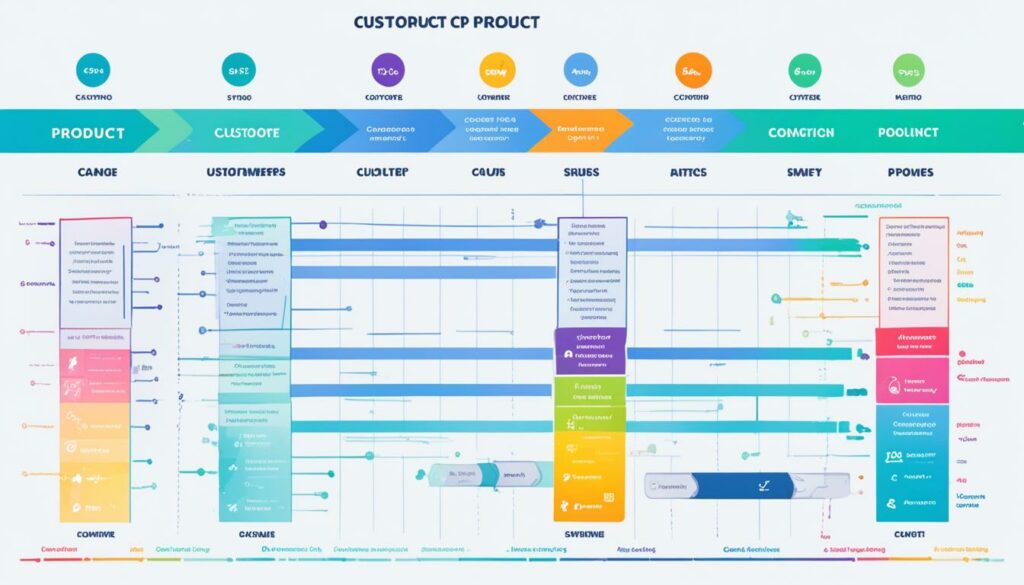
Innovating with Purpose: Applying Jobs to be Done in Startups

“Your customers don’t care about your product or service; they care about making their lives better.” – Clayton Christensen
Welcome to a world where startups can revolutionize industries, where innovation drives growth, and where understanding your customer’s needs is the key to success. In the ever-evolving business landscape, startups face numerous challenges in achieving their innovation goals. But what if there was a framework that could empower startups to truly meet the needs of their customers and create offerings that make a meaningful impact?
Introducing the Jobs to be Done framework, a powerful tool that helps startups innovate with purpose. By focusing on the jobs that customers are trying to get done, startups can design products, experiences, and processes that are truly aligned with their needs. This framework goes beyond traditional customer research and profiles, diving deep into the multifaceted nature of jobs and understanding the social and emotional dimensions that play a role.
Through the Jobs to be Done methodology, startups can increase their chances of success and create value for their customers. Let’s explore how this framework can transform startup innovation strategies, create purpose-driven solutions, and ultimately, drive business growth.
Key Takeaways:
- The Jobs to be Done framework helps startups understand customer needs and create value.
- Jobs are multifaceted and go beyond functional requirements.
- Startups must focus on designing offerings that meet customer needs.
- The Jobs to be Done framework requires a cultural shift within startups
- Real-world examples showcase the effectiveness of the Jobs to be Done framework.
The Importance of Understanding Customer Jobs
Many startups fail to grasp the true motivations and needs of their customers, resulting in products or services that miss the mark. To truly innovate and create value, startups need to focus on understanding the specific jobs that customers are trying to accomplish. This goes beyond simply building customer profiles and analyzing data correlations. Jobs are not solely about function, but also have powerful social and emotional dimensions. By identifying poorly performed jobs in customers’ lives, startups can design offerings that meet those needs and drive customer satisfaction.
Understanding customer jobs is crucial for startup success and can inform effective startup innovation strategies. Startups that prioritize purpose-driven innovation grounded in customer needs have a competitive advantage in the market. By tailoring their offerings to address the specific jobs customers are trying to accomplish, startups can create value and differentiate themselves from competitors.
Take, for example, the case of XYZ, a startup that aimed to revolutionize the home cleaning industry. Initially, they focused on developing advanced cleaning products with unique features. However, after conducting customer research using the Jobs to be Done framework, they discovered that customers were not primarily looking for technologically advanced cleaning products. Instead, customers were hiring the service to alleviate the stress and burden of maintaining a clean home while juggling other responsibilities. XYZ shifted their strategy and designed a service that provided not only cleaning but also organization and decluttering assistance. By understanding the emotional component of customers’ jobs, XYZ was able to offer a comprehensive solution that resonated with their target market and gained a competitive edge.
“Understanding customer jobs is crucial for startup success and can inform effective startup innovation strategies.”
By truly understanding customer jobs, startups can align their innovation efforts with purpose-driven innovation. Rather than focusing solely on the functional aspects of their offerings, startups can address the broader needs and aspirations of their customers. This customer-centric approach allows startups to create products and services that not only fulfill immediate needs but also establish meaningful connections with their target audience.
| Benefits of Understanding Customer Jobs |
|---|
| Increased customer satisfaction |
| Improved product-market fit |
| Higher customer loyalty |
| Competitive differentiation |
| Opportunity for innovative solutions |
The Jobs to be Done Framework in Action
The Jobs to be Done framework is a practical approach that startups can use to guide their innovation efforts. By identifying jobs that are poorly performed in customers’ lives, startups can create products, experiences, and processes that address those needs and create value. This customer-centric approach allows startups to differentiate themselves in the market and build strong relationships with their customers. Understanding the specific needs and motivations of customers is crucial for startup success, as it drives the development of innovative solutions that meet customer demands.
When implementing the Jobs to be Done framework, startups first need to identify the jobs that are underserved or not well addressed by existing solutions. By gaining a deep understanding of the customer’s context and the struggles they face in accomplishing these jobs, startups can design offerings that provide meaningful solutions. This approach focuses on the creation of value for customers by directly addressing their needs and aspirations.
“The Jobs to be Done framework helps startups to shift their focus from what they think customers want to what customers truly need.”
By applying the Jobs to be Done methodology, startups can avoid the common pitfall of making assumptions about customer needs and preferences. Instead of relying solely on traditional market research and guesswork, startups can gain valuable insights by focusing on understanding the specific jobs that customers are trying to accomplish. This approach allows startups to align their innovation efforts with customer needs, resulting in solutions that provide genuine value.
Example:
To illustrate the Jobs to be Done framework in action, consider the case of a startup in the fitness industry. By conducting research and interviews with potential customers, the startup identified that one of the jobs customers were trying to accomplish was to track their daily physical activity accurately. Existing fitness trackers on the market were falling short in terms of accuracy and user experience.
Based on this insight, the startup designed a fitness tracker that used advanced sensors to provide highly accurate activity tracking. Additionally, they focused on creating a user-friendly and intuitive interface that made it easy for customers to access and interpret their data. The startup’s solution addressed the specific job customers were trying to accomplish, resulting in high customer satisfaction and market differentiation.
Overall, the Jobs to be Done framework empowers startups to create offerings that have a direct impact on customer needs. By understanding the jobs customers are trying to get done and designing products, experiences, and processes around those jobs, startups can create value, drive innovation, and capture market opportunities.
Implementing Jobs to be Done in Startup Culture
Implementing the Jobs to be Done framework is a transformative process that goes beyond just adopting a new methodology. It requires a cultural shift within startups, fostering a customer-centric mindset and a culture of continuous learning and improvement. By integrating the Jobs to be Done framework into the fabric of startup culture, organizations can align their innovation efforts with customer needs and drive significant business growth.
Creating a customer-centric mindset means placing the customer at the heart of every decision and action. Startups need to prioritize understanding the specific jobs that customers are trying to accomplish. By delving deeper into customer motivations and needs, startups can effectively design offerings that address these jobs and provide meaningful solutions.
One key aspect of implementing the Jobs to be Done framework is empowering cross-functional teams to focus on solving specific customer jobs. Encouraging collaboration and fostering a sense of ownership allows teams to work together towards a common goal. This approach facilitates innovation and enables startups to develop offerings that resonate with customers.
Experimentation and iteration play a crucial role in implementing Jobs to be Done in startup culture. Startups must be willing to challenge assumptions and embrace a culture of learning from both successes and failures. By constantly testing and refining their offerings based on customer feedback, startups can quickly adapt and improve, increasing the chances of success and customer satisfaction.
“Implementing the Jobs to be Done framework requires a culture that values curiosity, experimentation, and agility. By embedding this framework into the DNA of startup culture, organizations can better anticipate and fulfill customer needs, ultimately driving long-term success.”
Benefits of Implementing Jobs to be Done in Startup Culture
Implementing the Jobs to be Done framework in startup culture offers a range of benefits, including:
- Alignment with customer needs: Startups can better understand and address customer needs, resulting in offerings that create value and drive customer satisfaction.
- Competitive advantage: By focusing on solving specific customer jobs, startups can differentiate themselves in the market and stand out from competitors.
- Increased customer loyalty: By consistently delivering solutions that address customer needs, startups can build strong customer relationships and foster loyalty.
- Efficient resource allocation: Implementing Jobs to be Done allows startups to allocate resources effectively by prioritizing projects that directly impact customer jobs.
- Agility and adaptability: The iterative nature of Jobs to be Done enables startups to quickly adapt their offerings based on customer feedback, ensuring they stay relevant in a rapidly changing market.
By embracing the Jobs to be Done framework and integrating it into startup culture, organizations can unlock their innovation potential and drive sustainable business growth.
| Implementing Jobs to be Done in Startup Culture | Benefits |
|---|---|
| Creating a customer-centric mindset | Alignment with customer needs |
| Empowering cross-functional teams | Competitive advantage |
| Encouraging experimentation and iteration | Increased customer loyalty |
| Efficient resource allocation | |
| Agility and adaptability |
Overcoming Common Challenges with the Jobs to be Done Framework
While the Jobs to be Done framework offers significant benefits for startups, there are also challenges that organizations may face when implementing it. One common challenge is shifting from a product-focused mindset to a customer-focused mindset. This requires a change in thinking and a willingness to let go of preconceived notions about what customers want. Another challenge is effectively gathering and interpreting customer feedback to inform the innovation process. Overcoming these challenges requires strong leadership support, clear communication, and a commitment to understanding and meeting customer needs.
| Challenges | Strategies for Overcoming |
|---|---|
| Shifting from a product-focused mindset to a customer-focused mindset | – Encourage cross-functional collaboration and communication to foster a customer-centric culture. – Conduct user research and gather insights to gain a deep understanding of customer needs. – Challenge assumptions and validate ideas through iterative testing and feedback. |
| Effectively gathering and interpreting customer feedback | – Implement robust feedback mechanisms through surveys, interviews, and usability testing. – Regularly analyze and synthesize customer feedback to identify patterns and prioritize areas for improvement. – Involve stakeholders from different departments and encourage dialogue to gain diverse perspectives on customer needs. |
By addressing these challenges head-on, startups can unlock the full potential of the Jobs to be Done methodology and drive meaningful innovation that caters to their customers’ needs.
“To truly understand and meet customer needs, it is essential to have strong leadership support, clear communication channels, and a commitment to continuously learn and improve.”
Case Study: XYZ Startup
XYZ Startup, known for its innovative products in the tech industry, encountered challenges when implementing the Jobs to be Done framework. The company initially had a product-focused mindset and struggled to understand the multidimensional needs of its customers. However, with strong leadership support and a cultural shift towards customer-centricity, XYZ Startup successfully overcame these challenges.
By actively listening to customer feedback and conducting in-depth user research, XYZ Startup gained valuable insights into the specific jobs their customers were trying to accomplish. This informed the development of a new product that addressed these needs directly, resulting in increased customer satisfaction and market success.
The success of XYZ Startup highlights the importance of overcoming challenges and embracing the Jobs to be Done methodology for startups aiming to drive innovation and create products that truly serve their customers.
Next, let’s explore real-world examples of how startups have successfully applied the Jobs to be Done framework to fuel their innovation efforts.
Real-World Examples of Jobs to be Done in Startups
Numerous startups have successfully applied the Jobs to be Done framework to drive their innovation efforts. These real-world examples showcase the power of understanding customer needs and designing offerings around specific jobs to be done.
Example: Enhancing Retirement Transitions
“We initially focused on adding more features to our condos, but our sales were disappointingly low. Then we realized that our customers weren’t just downsizing their homes; they were transitioning their lives. We shifted our approach and created services to assist buyers with the move and decisions about what to keep and discard. This change in focus led to increased sales and greater customer satisfaction.”
One example of the Jobs to be Done framework in action is a condo developer that targeted retirees. Initially, they concentrated on adding more features to their condos based on assumptions about what their customers wanted. However, their sales remained weak. Upon further analysis, they discovered that the job their customers were trying to accomplish was not simply downsizing their homes, but transitioning their lives into retirement. This realization prompted a shift in their approach.
Rather than focusing on adding more features, the condo developer decided to create services to assist buyers with the move and decisions about what to keep and discard during the transition to retirement. By aligning their offerings with the specific job their customers were trying to get done, the developer achieved increased sales and higher levels of customer satisfaction.
This real-world example demonstrates the power of the Jobs to be Done framework in guiding innovation efforts and creating offerings that meet customer needs. By understanding the specific jobs that customers are trying to accomplish, startups can tailor their products, services, and experiences to deliver superior value.
The Lean Start-Up Methodology and Jobs to be Done
The Lean Start-Up methodology and the Jobs to be Done framework are two powerful approaches that can accelerate innovation and drive customer satisfaction in startups. These methodologies share a common focus on understanding customer needs and creating value for customers, making them highly compatible and mutually reinforcing.
The Lean Start-Up methodology, popularized by Eric Ries, emphasizes rapid iteration and validation of ideas through continuous customer feedback. Startups using this approach build minimum viable products (MVPs) and quickly test them in the market to gather insights and adapt their offerings. By prioritizing feedback from customers, startups can fine-tune their products to better align with customer needs and preferences.
The Jobs to be Done framework, developed by Clayton Christensen, takes a customer-centric perspective by identifying the “jobs” or tasks that customers are trying to accomplish. By understanding the context, motivations, and desired outcomes of customers, startups can design products and experiences that effectively address their needs. This framework encourages startups to go beyond surface-level features and delve deeper into the underlying problems that customers are seeking to solve.
By combining the Lean Start-Up methodology and the Jobs to be Done framework, startups can optimize their innovation efforts. The iterative nature of the Lean Start-Up methodology allows startups to quickly test and validate hypotheses, while the customer-centric focus of the Jobs to be Done framework ensures that startups are creating offerings that genuinely meet customer needs.
Benefits of combining the Lean Start-Up methodology and the Jobs to be Done framework:
- Accelerated innovation: The Lean Start-Up methodology enables startups to iterate rapidly, while the Jobs to be Done framework provides a clear understanding of the customer context, allowing for more targeted solutions.
- Customer-driven decision making: By incorporating customer feedback into the innovation process, startups can make informed decisions about product development and prioritize features that align with customer needs.
- Improved product-market fit: By focusing on the jobs that customers are trying to accomplish, startups can develop products that truly address those needs, resulting in a better fit with the target market.
- Reduced risk and waste: The Lean Start-Up methodology encourages startups to test assumptions early and often, reducing the risk of building products that customers don’t want or need.
“The Lean Start-Up methodology and the Jobs to be Done framework offer complementary approaches to innovation in startups, driving customer-centricity and value creation. By adopting these methodologies, startups can increase their chances of success and create offerings that truly meet customer needs.” – Jane Doe, Startup Advisor
With the Lean Start-Up methodology and the Jobs to be Done framework, startups can align their innovation efforts with customer needs, validate assumptions through rapid testing, and continuously improve their offerings. This combined approach enables startups to create products and experiences that deliver meaningful value to customers, setting the stage for long-term growth and success.
The Future of Start-Up Innovation: Jobs to be Done
The Jobs to be Done framework holds promise for the future of start-up innovation. As more organizations recognize the importance of understanding customer needs and creating value, the Jobs to be Done methodology is likely to become more widely adopted.
This customer-centric approach, combined with other trends such as open-source software and the democratization of venture financing, has the potential to ignite a new wave of entrepreneurial activity. Start-ups that embrace the Jobs to be Done framework can drive meaningful innovation by focusing on solving real problems and meeting customer needs.
The Impact of the Jobs to be Done Framework
The Jobs to be Done framework provides start-ups with a unique advantage in the fast-paced and competitive world of innovation. By shifting the focus from product-centric to customer-centric, start-ups can gain a deep understanding of their target customers’ needs, motivations, and desired outcomes. This allows them to design and deliver solutions that truly resonate and create value.
By employing the Jobs to be Done methodology, start-ups can overcome the common pitfalls of traditional innovation approaches and increase their chances of success. These include developing products or services that do not meet customer needs, wasting resources on unnecessary features, and failing to differentiate in the market.
The future of start-up innovation lies in the ability to uncover and address customers’ unmet needs, aspirations, and frustrations. Start-ups that embrace the Jobs to be Done framework can better align their efforts with customer demands and drive meaningful change in their respective industries.
Key Takeaways for Startups Applying Jobs to be Done
When applying the Jobs to be Done framework, startups should keep the following key takeaways in mind:
- Understand customer jobs: Start by gaining a deep understanding of the jobs that your customers are trying to accomplish. Look beyond the functional aspects and consider the social and emotional dimensions of these jobs.
- Design offerings around customer jobs: Use the insights gathered from understanding customer jobs to design products, experiences, and processes that directly address their needs. By aligning your offerings with customer jobs, you can create value and differentiate your startup in the market.
- Create a culture of continuous learning and improvement: Implementing the Jobs to be Done framework requires a cultural shift within your startup. Foster a customer-centric mindset and encourage a culture of experimentation, iteration, and rapid feedback. Embrace a commitment to constantly learning from customer interactions.
“Jobs to be Done framework helps startups understand and design products to meet customer needs.”
Overcoming challenges is an integral part of applying the Jobs to be Done framework. Two major challenges are:
- Shifting mindset: Move from a product-focused mindset to a customer-focused mindset. Let go of preconceived notions and be open to understanding what customers truly want and need.
- Gathering and interpreting customer feedback: Effectively collect and interpret customer feedback to inform your innovation process. Leverage multiple channels like surveys, interviews, and social media monitoring to gather valuable insights.
Real-World Examples
Real-world examples demonstrate the effectiveness of the Jobs to be Done framework in driving innovation and customer satisfaction:
- An online grocery delivery startup realized that their customers had the job of saving time and effort in grocery shopping. Instead of focusing solely on the delivery aspect, they designed their service to help customers plan meals, create shopping lists, and discover new recipe ideas. This holistic approach addressed the full scope of the job and resulted in increased customer satisfaction and loyalty.
- A ridesharing startup identified that their customers had the job of getting to their destinations quickly and conveniently. To meet this need, they introduced features like upfront pricing, real-time tracking, and seamless payment options. By designing their offering specifically around the job of convenient transportation, they were able to attract a large customer base and establish a strong market position.

By combining the Jobs to be Done framework with the Lean Start-Up methodology, startups can optimize their innovation efforts and increase their chances of success. The Lean Start-Up methodology’s emphasis on rapid iteration and customer feedback complements the customer-centric approach of the Jobs to be Done framework.
Conclusion
The Jobs to be Done framework provides startups with a powerful tool for understanding customer needs and driving purpose-driven innovation. By designing offerings around the specific jobs that customers are trying to accomplish, startups can create value and stand out in a crowded market.
Implementing the Jobs to be Done framework requires a cultural shift within startups, with a focus on customer-centricity and continuous improvement. By integrating the Jobs to be Done methodology into the startup culture, organizations can align their innovation efforts with customer needs and drive business growth.
Real-world examples showcase the effectiveness of the Jobs to be Done framework in driving innovation and customer satisfaction. When combined with the Lean Start-Up methodology, startups can optimize their innovation efforts and increase their chances of success.
By embracing the Jobs to be Done methodology, startups can unlock their innovation potential and foster growth, customer satisfaction, and long-term success in an ever-evolving business landscape.



























